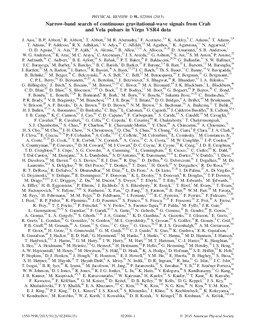| dc.contributor.author | LIGO Scientific Collaboration | |
| dc.contributor.author | Virgo Collaboration | |
| dc.contributor.author | Reula, O. | |
| dc.contributor.author | Dominguez, E. | |
| dc.contributor.author | Maglione, C. | |
| dc.contributor.author | Ortega, W. | |
| dc.contributor.author | Quiroga, G. | |
| dc.contributor.author | Aasi, J. | |
| dc.date.accessioned | 2022-03-31T18:22:46Z | |
| dc.date.available | 2022-03-31T18:22:46Z | |
| dc.date.issued | 2015 | |
| dc.identifier.citation | J. Aasi et al. Narrow-band search of continuous gravitational-wave signals from Crab and Vela pulsars in Virgo VSR4 data.
Phys. Rev. D 91, 022004 – Published 21 January 2015 https://doi.org/10.1103/PhysRevD.91.022004 | |
| dc.identifier.uri | http://hdl.handle.net/11086/23541 | |
| dc.identifier.uri | https://doi.org/10.1103/PhysRevD.91.022004 | |
| dc.description | Paper producido por "The LIGO Scientific Collaboration and the Virgo Collaboration". (En el registro se mencionan solo algunos autores de las decenas de personas que participan). | es |
| dc.description.abstract | In this paper we present the results of a coherent narrow-band search for continuous gravitational-wave signals from the Crab and Vela pulsars conducted on Virgo VSR4 data. In order to take into account a possible small mismatch between the gravitational wave frequency and two times the star rotation frequency, inferred from measurement of the electromagnetic pulse rate, a range of 0.02 Hz around two times the star rotational frequency has been searched for both the pulsars. No evidence for a signal has been found and 95% confidence level upper limits have been computed both assuming polarization parameters are completely unknown and that they are known with some uncertainty, as derived from X-ray observations of the pulsar wind torii. For Vela the upper limits are comparable to the spin-down limit, computed assuming that all the observed spin-down is due to the emission of gravitational waves. For Crab the upper limits are about a factor of two below the spin-down limit, and represent a significant improvement with respect to past analysis. This is the first time the spin-down limit is significantly overcome in a narrow-band search. | es |
| dc.format.medium | Electrónico y/o Digital | |
| dc.language.iso | eng | es |
| dc.rights | Attribution-NonCommercial-NoDerivatives 4.0 International | * |
| dc.rights.uri | http://creativecommons.org/licenses/by-nc-nd/4.0/ | * |
| dc.subject | Waves | en |
| dc.subject | Gravitational | en |
| dc.subject | LIGO | en |
| dc.title | Narrow-band search of continuous gravitational-wave signals from Crab and Vela pulsars in Virgo VSR4 data | en |
| dc.type | article | es |
| dc.description.version | publishedVersion | es |
| dc.description.fil | Fil: Maglione, C. Argentinian Gravitational Wave Group; Argentina. | es |
| dc.description.fil | Fil: Quiroga, G. Argentinian Gravitational Wave Group; Argentina. | es |
| dc.description.fil | Fil: Reula, O. Argentinian Gravitational Wave Group; Argentina. | es |
| dc.description.fil | Fil: Dominguez, E. Argentinian Gravitational Wave Group; Argentina. | es |
| dc.description.fil | Fil: Ortega, W. Argentinian Gravitational Wave Group; Argentina. | es |
| dc.description.fil | Fil: Aasi, J. LIGO. California Institute of Technology; Estados Unidos de América. | |
| dc.journal.country | Estados Unidos | es |
| dc.journal.editorial | American Physical Society | es |
| dc.journal.number | 2 | es |
| dc.journal.referato | Con referato | |
| dc.journal.title | PHYSICAL REVIEW D : covering particles, fields, gravitation, and cosmology | es |
| dc.journal.volume | 91 | es |
| dc.description.field | Física de Partículas y Campos | |





